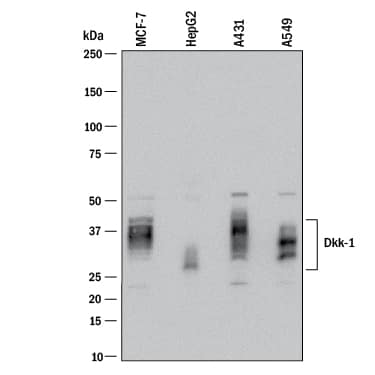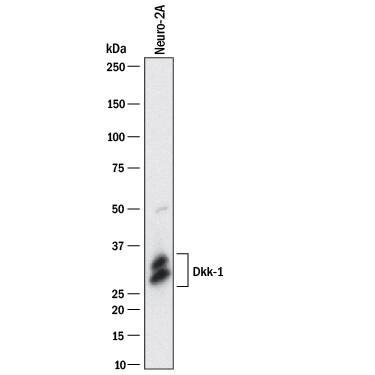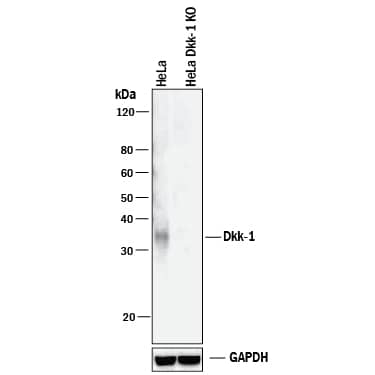Human/Mouse Dkk-1 Antibody
R&D Systems, part of Bio-Techne | Catalog # AF1096


Key Product Details
Validated by
Species Reactivity
Validated:
Cited:
Applications
Validated:
Cited:
Label
Antibody Source
Product Specifications
Immunogen
Thr32-His266
Accession # O94907
Specificity
Clonality
Host
Isotype
Endotoxin Level
Scientific Data Images for Human/Mouse Dkk-1 Antibody
Detection of Human Dkk‑1 by Western Blot.
Western blot shows lysates of MCF-7 human breast cancer cell line, HepG2 human hepatocellular carcinoma cell line, A431 human epithelial carcinoma cell line, and A549 human lung carcinoma cell line. PVDF membrane was probed with 1 µg/mL of Goat Anti-Human/Mouse Dkk-1 Antigen Affinity-purified Polyclonal Antibody (Catalog # AF1096) followed by HRP-conjugated Anti-Goat IgG Secondary Antibody (Catalog # HAF017). Specific bands were detected for Dkk-1 at approximately 28-40 kDa (as indicated). This experiment was conducted under reducing conditions and using Immunoblot Buffer Group 1.Detection of Mouse Dkk‑1 by Western Blot.
Western blot shows lysates of Neuro-2A mouse neuroblastoma cell line. PVDF membrane was probed with 1 µg/mL of Goat Anti-Human/Mouse Dkk-1 Antigen Affinity-purified Polyclonal Antibody (Catalog # AF1096) followed by HRP-conjugated Anti-Goat IgG Secondary Antibody (Catalog # HAF017). Specific bands were detected for Dkk-1 at approximately 28-40 kDa (as indicated). This experiment was conducted under reducing conditions and using Immunoblot Buffer Group 1.Western Blot Shows Human Dkk‑1 Specificity by Using Knockout Cell Line.
Western blot shows lysates of HeLa human cervical epithelial carcinoma parental cell line and Dkk-1 knockout HeLa cell line (KO). PVDF membrane was probed with 0.2 µg/mL of Goat Anti-Human/Mouse Dkk-1 Antigen Affinity-purified Polyclonal Antibody (Catalog # AF1096) followed by HRP-conjugated Anti-Goat IgG Secondary Antibody (Catalog # HAF017). A specific band was detected for Dkk-1 at approximately 35 kDa (as indicated) in the parental HeLa cell line, but is not detectable in knockout HeLa cell line. GAPDH (Catalog # AF5718) is shown as a loading control. This experiment was conducted under reducing conditions and using Immunoblot Buffer Group 1.Applications for Human/Mouse Dkk-1 Antibody
Blockade of Receptor-ligand Interaction
Knockout Validated
Western Blot
Sample: MCF‑7 human breast cancer cell line, HepG2 human hepatocellular carcinoma cell line, A431 human epithelial carcinoma cell line, A549 human lung carcinoma cell line, and Neuro‑2A mouse neuroblastoma cell line
Reviewed Applications
Read 1 review rated 4 using AF1096 in the following applications:
Formulation, Preparation, and Storage
Purification
Reconstitution
Formulation
Shipping
Stability & Storage
- 12 months from date of receipt, -20 to -70 °C as supplied.
- 1 month, 2 to 8 °C under sterile conditions after reconstitution.
- 6 months, -20 to -70 °C under sterile conditions after reconstitution.
Background: Dkk-1
Dickkopf related protein 1 (Dkk-1) is a member of the Dkk protein family that includes Dkk-1, -2, -3, and -4 (1). All four members are secreted proteins that are synthesized as precursor proteins with an N-terminal signal peptide and 2 conserved cysteine-rich domains, which are separated by a linker region. Dkk proteins have potential furin type proteolytic cleavage sites, and short forms of Dkk-2 and Dkk-4 containing only the second cysteine-rich domain can be generated by proteolytic processing (1). Dkk proteins have distinct patterns of expression in adult and embryonic tissues, suggesting that they may play diverse roles in these tissues. The Dkk proteins have distinct effects on Wnt signaling. Dkk-1 and Dkk-4 are Wnt antagonists. Dkk-3 has not been demonstrated to affect Wnt signaling, and Dkk-2 acts as an agonist or antagonist, depending on the cellular context. Wnt signaling regulates many important developmental processes including neural crest differentiation, brain development, kidney morphogenesis, and sex determination. In addition, Wnt signaling has also been implicated in tumor formation. Canonical Wnt signaling via the beta-catenin pathway is transduced by a receptor complex composed of the Frizzled proteins (Fz) and low-density lipoprotein (LDL) receptor-related proteins (LRP5/6) (2, 3). Unlike many soluble Wnt antagonists that function by binding extracellular Wnt ligands to prevent interaction of Wnt with the Fz-LRP5/6 receptor complex, Dkk-1 and Dkk-4 antagonize Wnt/ beta-catenin signaling by direct high-affinity binding to the Wnt coreceptor LRP5/6 and inhibiting interaction of LRP5/6 with the Wnt-Frizzled complex (4). Dkk-1 and Dkk-4 also bind the transmembrane proteins Kremen1 (Krm1) and Krm2 with high-affinity (5). Krm2 has been shown to form a ternary complex with Dkk-1 or -4 and LRP5/6 to trigger internalization of the complex and removal LRP6 from the cell surface. Thus, Dkk-1/4 and Kremens function synergistically to antagonize LRP5/6-mediated Wnt activity. Dkk-2 also binds to LRP5/6 and the Kremens, but Dkk-2 acts as antagonist of the Wnt signaling pathway only in the presence of Krm2 (5, 6). Dkk 2 binding to LRP5/6 in the absence of Krm2 activates rather than inhibits Wnt signaling (6).
References
- Krupnik, V.E. et al. (1999) Gene 238:301.
- Zorn, A.M (2001) Current Biology R592.
- Mao, J. et al. (2001) Mol. Cell 7:801.
- Nusse, R. et al. (2001) Nature 411:255.
- Mao, J. et al. (2002) Nature 417:664.
- Mao, B. and C. Niehrs (2003) Gene 302:179.
Long Name
Alternate Names
Gene Symbol
UniProt
Additional Dkk-1 Products
Product Documents for Human/Mouse Dkk-1 Antibody
Product Specific Notices for Human/Mouse Dkk-1 Antibody
For research use only

